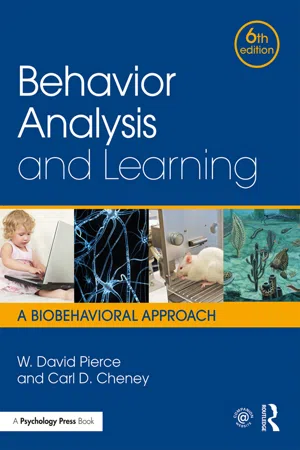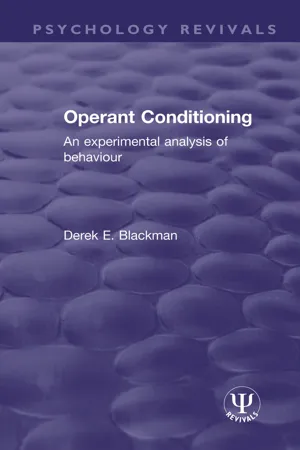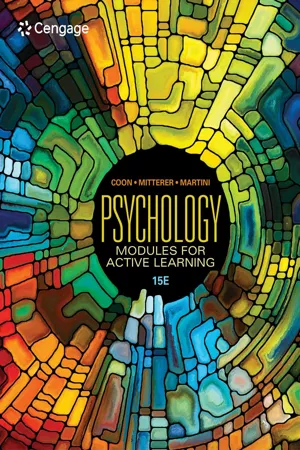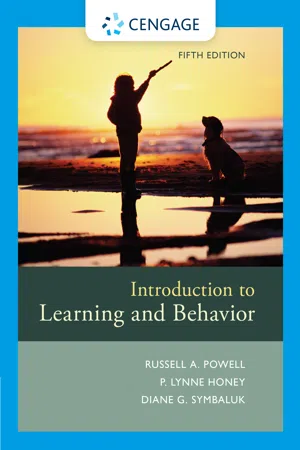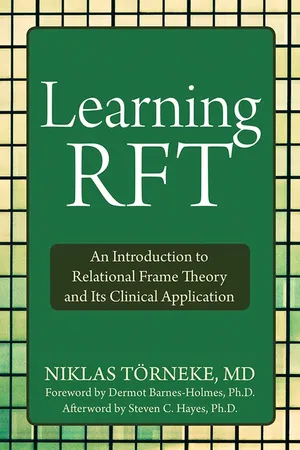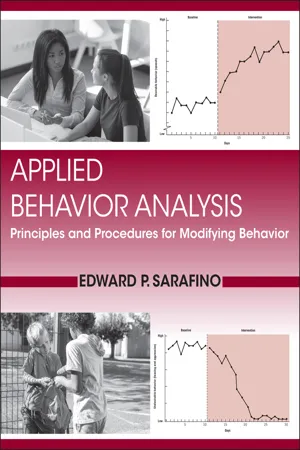Psychology
Operant Conditioning
Operant conditioning is a learning process in which behavior is strengthened or weakened by the consequences that follow it. It involves the use of reinforcement and punishment to shape behavior. This concept, developed by B.F. Skinner, has been widely applied in various fields, including education, parenting, and therapy.
Written by Perlego with AI-assistance
Related key terms
1 of 5
12 Key excerpts on "Operant Conditioning"
- eBook - PDF
- James Kalat, , , (Authors)
- 2021(Publication Date)
- Cengage Learning EMEA(Publisher)
That is the main point of Operant Conditioning. Summary ● Behaviorism. Behaviorists emphasize how environmental con-tingencies mold behavior. (page 190) ● Reinforcement. Edward Thorndike defined reinforcement as the process of increasing the future probability of the preced-ing response. (page 190) ● Operant Conditioning. Operant Conditioning is the process of controlling the rate of a behavior through its consequences. It contrasts with classical conditioning, in which the individual’s responses do not alter the probability of the outcome. (page 191) ● Disequilibrium principle. If someone has been deprived of the opportunity to engage in a behavior, then the opportunity to return to that behavior is reinforcing. (page 192) ● Primary and secondary reinforcers. Primary reinforcers such as food are reinforcing because of their own properties. Secondary reinforcers such as money become reinforcing be-cause of their association with primary reinforcers. (page 192) ● Reinforcement and punishment. In most cases positive rein-forcement is a more reliable way of influencing behavior than punishment is. (page 192) ● Extinction. In Operant Conditioning, a response is extinguished if it is no longer followed by reinforcement. (page 194) ● Shaping and chaining. Shaping trains a behavior by rein-forcing successive approximations to it. Chaining trains a sequence of behaviors by making each step an opportunity to perform the next step. (page 195) ● Schedules of reinforcement. The frequency and timing of a response depend on the schedule of reinforcement. In a ratio schedule of reinforcement, an individual is given reinforce-ment after a fixed or variable number of responses. In an interval schedule of reinforcement, an individual is given rein-forcement after a fixed or variable period of time. Extinction is slower after intermittent reinforcement than after continuous reinforcement. - eBook - ePub
Behavior Analysis and Learning
A Biobehavioral Approach, Sixth Edition
- W. David Pierce, Carl D. Cheney(Authors)
- 2017(Publication Date)
- Routledge(Publisher)
Reinforcement and Extinction of Operant Behavior 4- Learn about operant behavior and the basic contingencies of reinforcement.
- Discover whether reinforcement undermines intrinsic motivation.
- Learn how to carry out experiments on Operant Conditioning.
- Delve into reinforcement of variability, problem solving, and creativity.
- Investigate operant extinction and resistance to extinction.
A hungry lion returns to the waterhole where it has successfully ambushed prey. A person playing slot machines wins a jackpot and is more likely to play again than a person who does not win. Students who ask questions and are told “That’s an interesting point worth discussing” are prone to ask more questions. When a professor ignores questions or gives fuzzy answers, students eventually stop asking questions. In these examples (and many others), the consequences that follow behavior determine whether it will be repeated.Recall that operant behavior is said to be emitted (Chapter 2 ). When operant behavior is selected by reinforcing consequences, it increases in frequency. Behavior not followed by reinforcing consequences decreases in frequency. This process, called Operant Conditioning, is a major way that the behavior of organisms is changed on the basis of ontogeny or life experience (i.e., learning). It is important, however, to recognize that Operant Conditioning, as a process, has evolved over species history and is based on genetic endowment. Biologically, operant (and respondent) conditioning as a general behavior-change process is based on phylogeny or species history. In other words, those organisms, whose behavior changed on the basis of consequences encountered during their lifetimes, were more likely to survive and reproduce than animals that did not evolve such a capacity. Adaptation by operant learning is a mechanism of survival that furthers reproductive success.Operant Behavior
Operant behavior is sometimes described as intentional, free, voluntary, or willful. Examples of operant behavior include conversations with others, driving a car, taking notes, reading a book, and painting a picture. From a scientific perspective, operant behavior is determined and lawful and may be analyzed in terms of its relationship to environmental events. Formally, responses that produce a change in the environment and increase in frequency due to that change are called operants. The term operant comes from the verb to operate and refers to behavior that operates on the environment to produce effects or consequences, which in turn strengthen the behavior. The consequences of operant behavior are many and varied and occur across all sensory dimensions. When you turn on a light, dial a telephone number, drive a car, or open a door, these operants result in visual clarity, conversation, reaching a destination, or entering a room. A positive reinforcer - eBook - ePub
Operant Conditioning
An Experimental Analysis of Behaviour
- Derek E. Blackman(Author)
- 2017(Publication Date)
- Taylor & Francis(Publisher)
This research is essentially the systematic development of the principles which have already been introduced to the reader in the earlier parts of this book. Operant Conditioning is an experimental analysis of the ways in which the behaviour which is emitted rather than elicited by external stimuli may nevertheless be a function of environmental events. Much of this approach to psychology has been achieved by the exhaustive study of the ways in which the emitted behaviour of animals in experimental situations comes under the control of different arrangements of reinforcers. The typical Operant Conditioning experiment specifies the form of behaviour which is to be associated with a reinforcer, rather than allowing the reinforcer to have coincidental relationships with any pattern of behaviour. To this extent, the experiments are similar to those discussed in the previous chapter. However, instead of developing interesting tricks, a pattern of behaviour is sought which it is possible to record easily and which the subject may emit as frequently as he 'wishes'. This has resulted in the detailed study of rather arbitrary patterns of behaviour which happen to be convenient both to experimenter and subject. In the case of rats and monkeys, this is to be found in the form of a press on a lever; with pigeons, a peck on a disc. So an experiment may investigate the effects of reinforcers which are dependent on a rat's lever-presses, these effects being expressed in terms of the frequency with which the lever is pressed. Of course, one is not suggesting that wild rats in their 'real' world go about pressing levers. However, it is argued that these patterns of behaviour may be taken as a model for other patterns of more 'normal' activity. The lever-press and the peck at a disc are operants, because this behaviour cannot be readily identified as being elicited by a preceding stimulus in the way that acid precedes salivation - eBook - PDF
Psychology
Modules for Active Learning
- Dennis Coon, John Mitterer, Tanya Martini, , Dennis Coon, John Mitterer, Tanya Martini, (Authors)
- 2021(Publication Date)
- Cengage Learning EMEA(Publisher)
Operant Conditioning—Send in the Reinforcements After reading this module you should be able to: 28.1 Explain how Operant Conditioning works, predict how positive and negative reinforcement and punish-ment will impact the likelihood that a behavior will be repeated, distinguish between generalization and discrimination in Operant Conditioning, and explain how shaping works 28.2 Name three factors that impact the effectiveness of reinforcement and punishment, differentiate between continuous and partial schedules of reinforcement, and name the four types of partial schedules of reinforcement 28.3 Contrast primary and secondary reinforcers and briefly discuss two instances of Operant Conditioning in everyday life ~LEARNING OUTCOMES~ In this module we discuss Operant Conditioning in some detail. Operant Conditioning (sometimes called instrumental conditioning ) is based on the consequences of responding. The basic principle is simple: Acts that are followed by a Operant (instrumental) conditioning Learning based on the positive or negative consequences of responding. Copyright 2022 Cengage Learning. All Rights Reserved. May not be copied, scanned, or duplicated, in whole or in part. Due to electronic rights, some third party content may be suppressed from the eBook and/or eChapter(s). Editorial review has deemed that any suppressed content does not materially affect the overall learning experience. Cengage Learning reserves the right to remove additional content at any time if subsequent rights restrictions require it. PSYCHOLOGY MODULES FOR ACTIVE LEARNING 238 positive consequence tend to be repeated (Lefrançois, 2012). A dog is much more likely to keep searching for food under a pillow if it finds food there (positive consequence). The dog will likely stop looking there if it fails to find food (no consequence) or finds something frightening (negative con-sequence). - eBook - PDF
- Russell Powell, P. Honey, Diane Symbaluk, , Russell Powell, P. Honey, Diane Symbaluk(Authors)
- 2016(Publication Date)
- Cengage Learning EMEA(Publisher)
Thus, Operant Conditioning is sort of a mini-evolution of an organism ’ s behaviors, in which behaviors that are adaptive (lead to favorable outcomes) become more frequent while behaviors that are nonadaptive (do not lead to favorable outcomes) become less frequent. The Operant Conditioning process can be conceptualized as involving three components: (1) a response that produces a certain consequence (e.g., lever press-ing produces a food pellet), (2) the consequence that serves to either increase or decrease the probability of the response that preceded it (e.g., the consequence of a food pellet increases the rat ’ s tendency to again press the lever), and (3) a discrim-inative stimulus that precedes the response and signals that a certain consequence is now available (e.g., a tone that signals that a lever press will now produce food). These components are examined in more detail below. Operant Behavior An operant behavior is a class of emitted responses that result in certain con-sequences; these consequences then affect the future probability or strength of those responses. Operant responses are sometimes simply called operants . Suppose, for example, that a rat presses a lever and receives a food pellet, with the result that it is more likely to press the lever in the future. Lever press ã Food pellet The effect : The future probability of lever pressing increases. Or Jonathan might tell a joke and receive a frown from the person he tells it to. He is now less likely to tell that person a joke in the future. Tell a joke ã Person frowns The effect: The future probability of telling a joke decreases. In each case, the behavior in question (the lever pressing or the joke telling) is an operant response (or an “ operant ” ) because its occurrence results in a certain consequence and that consequence affects the future probability of the response. - eBook - PDF
- Torneke, Niklas(Authors)
- 1010(Publication Date)
- Context Press(Publisher)
Still, I will provide a short summary here, before turning to this book’s main quest, which is to point out how these principles should be used to shed light upon the function of human thinking. The two fundamental principles for behavior analysis are operant and respondent conditioning. The latter has been described since Pavlov’s well- known experiment with dogs at the beginning of the twentieth century, including how their natural reaction of salivation can be influenced through conditioning. Operant Conditioning is the principle of learning that Skinner investigated and demonstrated via his experiments, so that is where I will begin. Operant Conditioning: Learning Through Consequences Human actions never take place in a vacuum. There is something pre- ceding and something following each action. It is among these contextual factors—those that precede and those that follow—that the behavioral analyst looks for answers to questions about what governs behavior. If someone, in a certain context, turns his eyes to me with a specific expression on his face, I might address him by saying something like “Can I help you?” My utter- ance is followed by a new occurrence: The person replies. So my action is followed by a consequence, in this case that someone answers me. The core principle in Operant Conditioning is that the consequences following a behav- ior (a response) influence the probability of the behavior being repeated. Let’s speculate a bit using two rather different consequences in the everyday example above. Imagine that what follows upon my utterance “Can I help you?” is that the person gives me a friendly smile and tells me what he wants. An alternative would be the response “Mind your own business, you jerk!” It is hard to say exactly how each of these consequences might influence the probability of me asking if I could help if someone else were to look at me with this specific facial expression in the future. - eBook - PDF
- Catherine A. Sanderson, Karen R. Huffman(Authors)
- 2019(Publication Date)
- Wiley(Publisher)
Real World Application Question [AQ3] Why do gamblers have such trouble quitting, even when they continue to lose money? Motortion Films/ Shutterstock.com blue jean images/Getty Images 180 CHAPTER 6 Learning As we’ve just seen, classical conditioning is based on what happens before we involuntarily respond: Something happens to us, and we learn a new response. In contrast, operant con- ditioning is based on what happens after we voluntarily perform a behavior (Cooper et al., 2019; Pear, 2016). We do something and learn from the consequences. Be sure to note that when a behavior is followed by reinforcement, it increases. When it’s followed by punishment, it decreases (Figure 6.7). The key point to remember is that consequences are the heart of Operant Conditioning (see cartoon). In classical conditioning, con- sequences are irrelevant—Pavlov’s dogs still got to eat whether they salivated or not. But in Operant Conditioning, the organism voluntarily performs a behavior (an operant) that produces a consequence—either reinforcement or punishment—and the behavior either increases or decreases. It’s also very important to note that reinforcement is the process by which adding or taking away a stimulus following a response increases the likelihood that the response will be repeated. Punishment, in con- trast, is the process by which adding or taking away a stimulus following a response decreases the likelihood that the response will be repeated. The power and problems with reinforcement and punishment will be explored later in this section. For now we want to highlight how they can be used to improve your everyday life. For example, allowing your- self to watch TV only while exercising is a form of reinforcement that will improve your general physical health. - eBook - ePub
- Julian Leslie(Author)
- 2015(Publication Date)
- Routledge(Publisher)
Chapter 2 ) and constitutes action that is often called 'wilful', or said to be done by 'free choice'. Our present analysis indicates that this behaviour is in some way related to, and thus influenced by, its consequences on previous occasions. For that reason we will replace the older term, purposive, with Skinner's term, 'operant'. Calling behaviour 'operant' (or in Thorndike's term, 'instrumental') suggests that, by operating on the environment the behaviour is instrumental in obtaining consequences: the behaviour 'does something' to the environment. The term 'operant' gets rid of the confusing conceptual scheme implied by 'purposive', and captures the fundamental notion that the past consequences of such behaviour are one of its important determinants.3.3 An Operant Conditioning Experiment in a Skinner Box
As discussed in Chapter 2 , B.F. Skinner took further the findings of E.L. Thorndike. He made a number of methodological innovations through using a very simplified environment in which consequences can be arranged for one class of behaviour. This has turned out to be a very useful situation for identifying behavioural processes. Indeed, it has often been described as the 'microscope of behaviour analysis'. Because of its importance, its use will be described in some detail. Although details are given here for the apparatus as used with one species, the laboratory rat, equivalent apparatus has been developed for a number of other species of mammals (including primates), birds, fish and even insects.A typical experiment can be carried out as follows. A laboratory rat is put into a small enclosure, such as the one shown in Figure 3.3 , and certain procedures are carried out. The significant features of the enclosure, called an operant test chamber or Skinner box - eBook - PDF
Applied Behavior Analysis
Principles and Procedures in Behavior Modification
- Edward P. Sarafino(Author)
- 2012(Publication Date)
- Wiley(Publisher)
From findings in this and other research, Thorndike (1911) later proposed the Law of Effect: ‘‘satisfying consequences,’’ such as rewards or escape from unpleasant circumstances, strengthen stimulus–response connections gradually in the process of learning. B. F. Skinner (1938) later studied learning processes in animals with an apparatus, often called the Skinner box, that had partway up a wall a lever projecting out and a tray below. When a hungry rat depressed the lever, a pellet of food dropped into the tray, which the animal could access. The food was used as a reward, which Skinner called a ‘‘reinforcer,’’ for the behavior of pressing the lever. Using this procedure and apparatus, Skinner demonstrated many features of reinforcement and its importance in learning. This chapter describes what reinforcement is and its importance in learning and changing behavior. We’ll discuss the main types of reinforcers and factors that affect how effective they are in modifying behavior. DEFINING REINFORCEMENT To reinforce means to strengthen, increase, or make more pronounced. In Operant Conditioning, reinforcement refers to the process in which a consequence of a behavior strengthens that behavior, making it more likely to occur in the future. The consequence is contingent on the behavior—that is, the consequence occurs if the behavior does. The object or event that serves as the consequence in reinforcement is called a reinforcer, a stimulus that is introduced or changed when the behavior occurs. Because reinforcement strengthens a behavior, measurement of that behavior in the future should show reduced latency or increased frequency, duration, or magnitude. If we provide a consequence for a behavior and the person does not perform it at least as quickly, frequently, persistently, or intensely, we have no evidence that our consequence was a reinforcer. - eBook - PDF
- Karen R. Huffman, Catherine A. Sanderson(Authors)
- 2013(Publication Date)
- Wiley(Publisher)
This was because Skinner believed that the only way to know how we have influenced someone’s behavior is to check whether it increases or decreases. As he pointed out, we too often think we’re reinforcing or punishing behavior when we’re actually doing the opposite (see Psychology and You). Operant Conditioning 161 Interestingly, when you make yourself do some necessary but tedious task—say, paying bills—before letting yourself go to the movies, you are not only using posi- tive reinforcement, you’re also using the Premack principle . This principle is named after psychologist David Premack, who found that any naturally occurring, high- frequency response can be used to reinforce and increase low-frequency responses (Goldfield, 2012; Poling, 2010). Recognizing that you love to go to movies, you intuitively tie your less desirable, low-frequency activity (paying bills) to your high- frequency or highly desirable behavior (going to the movies). It’s very important to note that negative reinforcement is NOT punishment. The two concepts are actually completely opposite. Reinforcement (both positive and negative) strengthens a behavior, whereas punishment (both positive and negative) weakens a behavior. Knowing that this terminology is confusing, we encourage you to think of positive and negative in a mathematical sense. Instead of automatically assuming that positive means something “good” and negative means something “bad,” recognize that, as in mathematics, positive is adding something [+], and neg- ative is taking something away [–]. As with reinforcement, there are two kinds of punishers—primary and second- ary, and two kinds of punishment—positive and negative. Primary punishers are unmet innate, biological needs (e.g., hunger, thirst, dis- comfort). Secondary punishers are unmet learned needs (e.g., poor grades, bad hair day, loss of an election). - eBook - PDF
- Catherine A. Sanderson, Karen R. Huffman(Authors)
- 2016(Publication Date)
- Wiley(Publisher)
The addition of the ticket for texting makes it less likely you will text while driving in the future. You study hard for your psychology exam, and still receive a low grade. The addition of the low grade after studying hard decreases the likelihood that you will study hard for future exams. A parent takes away a teen’s cell phone following a poor report card. The removal of the phone makes it less likely that the teen will earn poor grades in the future. You argue aggressively with your friend, and he or she goes home. The removal of your friend’s presence decreases the likelihood that you’ll argue aggressively in the future. © Fertnig/iStockphoto Arcady/Shutterstock Operant Conditioning 157 FIGURE 6.7 Using the “Skinner box” for both reinforcement and punishment To test his behavioral theories, Skinner created an Operant Conditioning chamber, popularly known as a “Skinner box.” Using this device, experimenters can teach subjects (like rats or pigeons) to perform specific behaviors, such as pressing a lever or pecking at a disk, in response to specific signals, such as a light or sound. In many experiments, the subject’s responses also are mechanically recorded. Do you see how this highly controlled environment helps reduce potential experimental errors? b. Use the blank lines in the four boxes below to fill in the label of the correct learning principle—positive reinforcement, negative reinforcement, positive punishment, or negative punishment. Answers: (a) positive reinforcement, (b) positive punishment, (c) negative reinforcement, (d) negative punishment a. In Skinner’s basic experimental design, an animal (such as a rat) could press a lever and food pellets or shocks (administered through an electric grid on the cage floor) could be used to administer reinforcement or punishment. - eBook - PDF
- Karen R. Huffman, Katherine Dowdell, Catherine A. Sanderson(Authors)
- 2017(Publication Date)
- Wiley(Publisher)
204 CHAPTER 6 Learning Your Professional Success demonstrates how these same principles can be used to improve your success in the business world. And, finally, if you’re feeling a bit overwhelmed with all the terms and concepts for both classical and Operant Conditioning, carefully study the sum- mary provided in Table 6.5. FIGURE 6.13 Operant Conditioning in everyday life Reinforcement and punishment shape behavior in many aspects of our lives. a. Prejudice and discrimination Although prejudice and discrimination show up early in life, children are not born believing others are inferior. How might posters like this one discourage children from developing (and adults from perpetu- ating) prejudice and discrimination? b. Superstition Like prejudice and discrimination, superstition is not some- thing we’re born with. These attitudes are learned—partly through operant condition- ing. For example, the baseball player stick- ing gum on his helmet in the photo might have once placed his gum on his helmet and then hit a home run. He associated the gum with winning and continued the practice in later games. c. Biofeedback To treat ailments such as anxiety or chronic pain, patients may be connected to electrodes and watch a monitor with a series of flashing lights that display changes in their internal bodily functions. The patients then use this “feedback” (flashing lights) to gauge their progress as they try various relaxation strategies to receive relief from the pain of muscle tension. ANDERW WALTERS/Alamy Stock Photo Duane Burleson/AP images © Bonnie Kamin/PhotoEdit-All rights reserved TABLE 6.5 Comparing Classical and Operant Conditioning Classical Conditioning Operant Conditioning Example Cringing at the sound of a dentist’s drill A baby cries and you pick her up Pioneers Ivan Pavlov John B.
Index pages curate the most relevant extracts from our library of academic textbooks. They’ve been created using an in-house natural language model (NLM), each adding context and meaning to key research topics.

